The role of surfactant protein A in bleomycin-induced acute lung injury
- PMID: 20167853
- PMCID: PMC2894409
- DOI: 10.1164/rccm.200907-1002OC
The role of surfactant protein A in bleomycin-induced acute lung injury
Abstract
Rationale: Surfactant protein A (SP-A) is a collectin family member that has multiple immunomodulatory roles in lung host defense. SP-A levels are altered in the bronchoalveolar lavage (BAL) fluid and serum of patients with acute lung injury and acute respiratory distress syndrome, suggesting the importance of SP-A in the pathogenesis of acute lung injury.
Objectives: Investigate the role of SP-A in the murine model of noninfectious lung injury induced by bleomycin treatment.
Methods: Wild-type (WT) or SP-A deficient (SP-A(-/-)) mice were challenged with bleomycin, and various indices of lung injury were analyzed.
Measurements and main results: On challenge with bleomycin, SP-A(-/-) mice had a decreased survival rate as compared with WT mice. SP-A(-/-) mice had a higher degree of neutrophil-dominant cell recruitment and the expression of the inflammatory cytokines in BAL fluid than did WT mice. In addition, SP-A(-/-) mice had increased lung edema as assessed by the increased levels of intravenously injected Evans blue dye leaking into the lungs. Terminal deoxynucleotidyl transferase-mediated dUTP-biotin nick end labeling and active caspase-3 staining suggested the increased apoptosis in the lung sections from SP-A(-/-) mice challenged with bleomycin. SP-A also specifically reduced bleomycin-induced apoptosis in mouse lung epithelial 12 cells in vitro. Moreover, intratracheal administration of exogenous SP-A rescued the phenotype of SP-A(-/-) mice in vivo.
Conclusions: These data suggest that SP-A plays important roles in modulating inflammation, apoptosis, and epithelial integrity in the lung in response to acute noninfectious challenges.
Figures
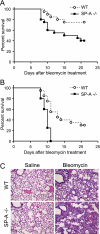
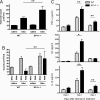

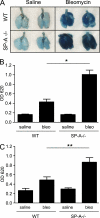

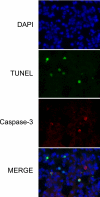
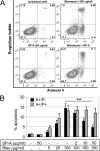
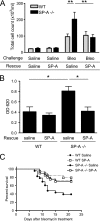
Similar articles
-
Lung surfactant protein D (SP-D) response and regulation during acute and chronic lung injury.Lung. 2013 Jun;191(3):295-303. doi: 10.1007/s00408-013-9452-x. Epub 2013 Feb 24. Lung. 2013. PMID: 23435873 Free PMC article.
-
Surfactant protein-D regulates effector cell function and fibrotic lung remodeling in response to bleomycin injury.Am J Respir Crit Care Med. 2012 Mar 1;185(5):525-36. doi: 10.1164/rccm.201103-0561OC. Epub 2011 Dec 28. Am J Respir Crit Care Med. 2012. PMID: 22198976 Free PMC article.
-
Characterization of lung stem cell niches in a mouse model of bleomycin-induced fibrosis.Stem Cell Res Ther. 2012 May 29;3(3):21. doi: 10.1186/scrt112. Stem Cell Res Ther. 2012. PMID: 22643035 Free PMC article.
-
Repetitive intratracheal bleomycin models several features of idiopathic pulmonary fibrosis.Am J Physiol Lung Cell Mol Physiol. 2010 Oct;299(4):L442-52. doi: 10.1152/ajplung.00026.2010. Epub 2010 Jun 18. Am J Physiol Lung Cell Mol Physiol. 2010. PMID: 20562227 Free PMC article.
-
Alveolar surfactant protein D content modulates bleomycin-induced lung injury.Am J Respir Crit Care Med. 2005 Oct 1;172(7):869-77. doi: 10.1164/rccm.200505-767OC. Epub 2005 Jun 30. Am J Respir Crit Care Med. 2005. PMID: 15994463 Free PMC article.
Cited by
-
Dipeptidyl peptidase IV is a human and murine neutrophil chemorepellent.J Immunol. 2013 Jun 15;190(12):6468-77. doi: 10.4049/jimmunol.1202583. Epub 2013 May 15. J Immunol. 2013. PMID: 23677473 Free PMC article.
-
Surfactant protein D attenuates sub-epithelial fibrosis in allergic airways disease through TGF-β.Respir Res. 2014 Nov 29;15(1):143. doi: 10.1186/s12931-014-0143-9. Respir Res. 2014. PMID: 25472740 Free PMC article.
-
Genetic variation in surfactant protein-A2 alters responses to ozone.PLoS One. 2021 Feb 22;16(2):e0247504. doi: 10.1371/journal.pone.0247504. eCollection 2021. PLoS One. 2021. PMID: 33617569 Free PMC article.
-
A Macrophage-Pericyte Axis Directs Tissue Restoration via Amphiregulin-Induced Transforming Growth Factor Beta Activation.Immunity. 2019 Mar 19;50(3):645-654.e6. doi: 10.1016/j.immuni.2019.01.008. Epub 2019 Feb 12. Immunity. 2019. PMID: 30770250 Free PMC article.
-
Animal models of fibrotic lung disease.Am J Respir Cell Mol Biol. 2013 Aug;49(2):167-79. doi: 10.1165/rcmb.2013-0094TR. Am J Respir Cell Mol Biol. 2013. PMID: 23526222 Free PMC article. Review.
References
-
- Ashbaugh DG, Bigelow DB, Petty TL, Levine BE. Acute respiratory distress in adults. Lancet 1967;2:319–323. - PubMed
-
- Wheeler AP, Bernard GR. Acute lung injury and the acute respiratory distress syndrome: a clinical review. Lancet 2007;369:1553–1564. - PubMed
-
- Wright JR. Immunoregulatory functions of surfactant proteins. Nat Rev Immunol 2005;5:58–68. - PubMed
-
- Borron P, McIntosh JC, Korfhagen TR, Whitsett JA, Taylor J, Wright JR. Surfactant-associated protein A inhibits LPS-induced cytokine and nitric oxide production in vivo. Am J Physiol Lung Cell Mol Physiol 2000;278:840–847. - PubMed
Publication types
MeSH terms
Substances
Grants and funding
LinkOut - more resources
Full Text Sources
Other Literature Sources
Research Materials

